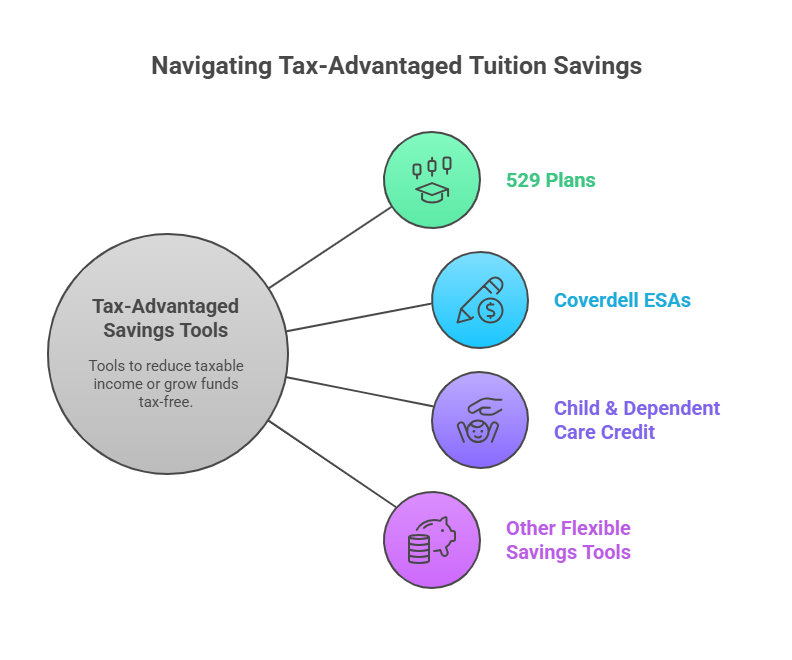With average private K-12 tuition reaching $16,000/year (NAIS 2024), families need every tax advantage. Here’s how to legally offset costs in 2026. Whether you’re paying for better academics, safety, or specialised programs, it’s natural to wonder: Can you claim private school tuition on taxes?
This guide tells you the answer to this question in 2026 and explains how U.S. federal and state regulations, Canadian loopholes, education savings accounts, K-12 tax credits, and tuition deductions could do it. You will also get to know how much of your spending is qualifiable, what is not and how you can optimise your expenses on education.
Can You Claim Private School Tuition on Taxes?
The question Can you claim the private school tuition as a tax is often raised by many families and is subject to the specifics of the country and state it is residents live in, and the possibility of their eligibility for certain programs. This is not a one-size-fits-all question. Each country has varied taxes, and within these variations, some states or provinces have regulations that may not be the same.
The majority of families are not able to deduct private school tuition fees on the federal tax in the U.S. Nevertheless, there is a K-12 tax credit offered in some states, and there exist financial instruments such as 529 plans and education savings accounts. In Canada, there are deductions on limited grounds, such as special needs or religious education.
Federal Tax Rules on Private School Tuition
You can’t generally deduct private school tuition from taxes in Canada unless the school provides religious education or supports special needs. Federal tax law in the U.S. offers very limited relief for K–12 private education costs. Most tuition payments are considered personal expenses and are not deductible.
However, exceptions exist, particularly for children with special needs. Understanding these nuances is essential if you’re planning to claim any school-related costs.
Federal Deduction: The General Rule
Under current IRS rules, K–12 private school tuition is not deductible at the federal level. The Internal Revenue Code treats tuition as a personal expense, regardless of whether the school is religious or secular.
This includes boarding school tuition, day school fees, and even registration charges. Families paying thousands per year generally receive no federal tax benefit unless they qualify under a specific exemption.
Exception for Special‑Needs Children
Understanding how to claim private school tuition on taxes Canada involves obtaining proper receipts, ensuring eligibility, and checking provincial rules.
Parents whose children attend private schools for specialised therapy or learning accommodations may qualify for a deduction under medical expenses.
According to IRS Publication 502, tuition can be deducted if the school provides essential medical care or learning interventions prescribed by a professional. This applies to schools serving children with ADHD, dyslexia, autism, and other disabilities.
Why is there No Federal Credit or deduction for K–12?
Federal law focuses educational tax relief on college and higher education, such as the American Opportunity Tax Credit (AOTC). This policy avoids broadly subsidising personal K–12 choices.
While some policymakers support school vouchers and tax credits for K–12, no federal legislation has made these widely available as of 2026.
State-Level Deductions & Tax Credits
If the federal government doesn’t offer relief, can states help? Fortunately, yes. Some U.S. states offer deductions or tax credits to ease the cost of private education.
State programs vary significantly in scope, eligibility, and process. Knowing your local tax law could save your family hundreds—or even thousands—each year.
Which States Offer K–12 Education Credits
Here are examples of states with K–12 education-related tax benefits:
- Illinois: Illinois: 25% tax credit for donations to scholarship funds (ILCS 35/224), not direct tuition payments.
- Indiana: $1,000 per child deduction for private tuition.
- Minnesota: Offers both deductions and credits.
- Arizona & Georgia: Tax-credit scholarship programs.
- South Carolina: Education savings accounts and refund initiatives.
How to Claim on State Returns
Earning your OSSD diploma online is a flexible and accredited way to complete high school from anywhere in the world. To claim these credits or deductions:
- Gather your tuition receipts and documentation.
- Review your state’s Department of Revenue website for instructions.
- Use relevant tax forms (e.g., Schedule ED in Illinois).
- File before the deadline and retain records for 3–5 years.
Also, verify if your school qualifies—some states require accreditation or nonprofit status.
How Recent Federal Voucher Proposals Impact Families
Several federal initiatives have proposed tax credits or “Education Freedom Scholarships” for private school families. Searching for private high schools near me can help you find institutions that align with your child’s academic goals and extracurricular interests.
Although these proposals are debated, none have passed as federal law by 2026. Still, their visibility has increased interest in state-level options and 529 plans for K–12 tuition.
Tax-Advantaged Accounts That Help Pay Tuition

Private school families can also benefit from tax-advantaged savings tools. While not deductions per se, these options allow you to reduce taxable income or grow funds tax-free.
Used strategically, these accounts can make tuition more manageable and offer long-term value.
529 Plans for K–12 Tuition
Before making a withdrawal, always check the 529 plan limits, which currently cap K–12 tuition use at $10,000 per student per year.
Benefits of 529 plans:
- Tax-free investment growth
- Tax-free withdrawals for tuition
- Potential state income tax deductions on contributions
Note: Not all states align with federal 529 rules—check your state’s policy.
Coverdell Education Savings Accounts (ESAs)
Coverdell ESAs are another way to save for K–12 or college expenses, with more flexible spending categories (e.g., tutoring, tech, uniforms).
They allow:
- $2,000 annual contributions per child
- Tax-free growth and withdrawals
- Income limits for contributors
While useful, their low contribution cap makes them best for supplementary expenses.
Child & Dependent Care Credit
Though not for tuition, this credit helps offset before- and after-school care costs for kids under 13. To claim tuition as a medical expense, families must retain proper special needs documentation, including a diagnosis and written recommendation from a licensed professional.
If your private school provides such services and both parents work or study full-time, you could claim up to $3,000 per child (or $6,000 for two children). Confirm eligibility with your tax advisor.
Other Flexible Savings Tools (FSAs, QTPs)
Some employers offer Flexible Spending Accounts (FSAs) or education reimbursement programs. These may cover enrichment, therapy, or hybrid schooling.
Also, note that QTPs (Qualified Tuition Programs) is another name for 529 plans. Always coordinate benefits to avoid IRS penalties for “double dipping.”
Planning Strategies & Real‑World Examples
When claiming education credits or tuition deductions, be sure to complete the appropriate state tax forms, such as Schedule ED or state-specific education credit worksheets.
Each state has unique requirements, so consult your Department of Revenue to access the right state tax forms before filing. Tax efficiency isn’t just about filing. It’s about planning—using legal strategies to stretch your dollars further.
Below are real-life examples and strategic comparisons to help guide your decisions.
Family Case Studies
Case 1: Illinois Family with Two Kids in Private School
- Contributes $10K/year to a 529 plan
- Claims $750 IL tax credit
- Uses Child Care Credit for after-school supervision
Case 2: Canadian Parent with Religious School Enrolment
- Receives charitable tax receipt for part of tuition
- Claims as donations on provincial return
- Keeps school-provided breakdown of instructional vs religious content
Preparing for 529 Changes in 2026
Some states are raising contribution caps or changing rollover rules for 529 plans.
For example, a new 2026 rule allows unused 529 funds to be rolled into a Roth IRA (under conditions). Start planning now to avoid end-of-year surprises.
Comparing Tax Vehicles (529 vs ESA vs State Credit)
| Tool | Benefit | Annual Limit | Key Considerations |
| 529 Plan | Tax-free growth & withdrawals | $10K for K–12 | Check state conformity |
| ESA | Flexible for tutoring, tech, etc. | $2K per child | Income-restricted |
| State Credit | Direct deduction or tax refund | Varies by state | The school must meet state qualifications |
What to Do Next: Your Tax-Planning Action List
Before tax season hits, organise your records and review the available benefits. A little preparation can lead to thousands in potential savings. When researching top academic options in Ontario, many families turn to Mississauga best private schools for their strong curriculum, university preparation, and supportive learning environments.
Here’s your checklist to stay ahead.
Checklist Before Filing
- Collect tuition invoices and tax receipts.
- Review 529 plan statements and withdrawals.
- Research state-specific deductions or credits
- Track special education or care-related expenses.
- Prepare questions for your tax advisor.
Pro Tips for Maximising Tax Benefits
- Contribute to a 529 early in the tax year.
- Understand state-specific rules on plan conformity.
- Don’t claim unqualified expenses (IRS audits are strict)
- Always keep documentation for 3–7 years.
- Use credits and deductions together when allowed.
Consult a Professional
Education tax laws can be complex—and change often. A certified tax advisor or financial planner can:
- Identify deductions you might miss
- Advise on strategy (ESA vs 529 vs credit)
- Help structure withdrawals to avoid penalties
Conclusion
So-can you claim private school tuition on taxes? In 2026, the short answer is still “no” at the federal level in the U.S. for most families. K–12 private school tuition is considered a personal expense and is not directly deductible on your federal tax return. However, that doesn’t mean you’re entirely out of options or opportunities to save.
With the right approach, families can still reduce their overall education-related tax burden through a mix of strategies. These include state-sponsored K–12 tax credits, tuition deductions, 529 plans, education savings accounts (ESAs), and limited but important exceptions, such as deductions for special-needs education or religious instruction in Canada. Some states even offer refundable education credits, and new 2026 rule changes are making it easier to roll over unused 529 funds into Roth IRAs. The key is to plan early, stay informed about both federal and state/provincial policies, and keep detailed documentation. Combining the right financial tools with expert tax advice can lead to meaningful savings even when full tuition deductibility isn’t available.
If you’re unsure which strategy fits your situation, consult a tax professional or financial advisor to ensure you’re maximising all legal benefits available for your child’s private education.
Frequently Asked Questions About Can You Claim Private School Tuition on Taxes?
1. What is the limit of school fees for income tax?
The IRS does not allow K–12 tuition deductions at the federal level, meaning parents cannot directly deduct private school fees from taxable income. However, you can use 529 plan funds to pay for K–12 tuition, with a limit of $10,000 per year per student. This withdrawal remains tax-free if used for eligible educational expenses. It’s important to note that not all states conform to federal rules, so check your local tax laws before using 529 funds.
2. How to write a letter to the school for income tax tuition fees?
To request documentation for tax purposes, write a formal letter or email to your school administration asking for a tuition fee receipt. The letter should request key details such as the student’s name, payment dates, total annual tuition, school’s EIN (Employer Identification Number), and academic year. In Canada, also request a T2202 slip (for eligible post-secondary programs) or a charitable donation breakdown if religious instruction is part of the tuition. Keep a signed copy for your tax records.
3. Are self tuition fees taxable?
Self-paid K–12 tuition fees for your child or yourself are generally not tax-deductible under current U.S. or Canadian tax laws. However, tuition paid for job-related certification, degree programs, or training courses may be deductible if they meet specific IRS or CRA guidelines. For example, in the U.S., the Lifetime Learning Credit or employer education assistance programs may offer relief if the education improves or maintains job skills. Always consult a tax advisor to confirm eligibility.
4. What is considered a taxable benefit in Canada?
In Canada, when an employer pays for an employee’s or their dependent’s private school tuition, it may be considered a taxable benefit. This means the tuition amount must be added to the employee’s income and taxed accordingly. However, exceptions may apply if the payment is made under a qualified relocation package or if the education is part of an approved education support program. CRA guidelines should be reviewed to ensure compliance and proper reporting on your T4 slip.









